What Kind of Marks Are Texans Giving Abbott?
As Dallas County cautiously eyes a possible plateau in new COVID-19 cases, many are wondering just how effective those shelter-in-place orders were in combating the virus. We take a look at that, the grade Gov. Greg Abbott has gotten so far, as well as some additional bullet points you need for today. We’ve also launched a survey of our own.
- What kind of marks are Texans giving Abbott?
- County officials cautiously optimistic about slight decline in new cases
- Abbott, state emergency management to partner with local fire departments for nursing home testing
- Buckner launches gold ribbon campaign in support of senior living
What Kind of Marks Are Texans Giving Abbott?
 Like it or not, Texas businesses are sputtering back to life after weeks of pandemic shut down. Gov. Greg Abbott rolled out a plan to slowly open first restaurants and retail, then barbershops and hair salons, and, as of today, other nonessential businesses and gyms.
Like it or not, Texas businesses are sputtering back to life after weeks of pandemic shut down. Gov. Greg Abbott rolled out a plan to slowly open first restaurants and retail, then barbershops and hair salons, and, as of today, other nonessential businesses and gyms.
Abbott will also hold a press conference today, where it is expected he will open more industries.
But how has the rollout – and the dustups with local officials around the state regarding who gets to manage their response to the novel coronavirus spread – impacted Abbott’s approval ratings?
A first inkling came last week with a large-scale Washington Post-Ipsos poll that had Abbott next-to-last when it came to the marks residents were giving governors – beating out only Georgia Gov. Brian Kemp. Fifty-seven percent approve of Abbott’s handling of the outbreak, which is actually a percentage point (and change) higher than the percentage of votes he got in 2018 – 55.8%.
What is unknown is whether he will improve his approval rating over time, or whether decisions now will drag it down to Kemp-level vistas.
Adding to the uncertainty about Abbott’s decision is a recent study from experts at UT Southwestern and the Center for Infectious Disease and Policy, which indicates that North Texas could be in for a bigger spike later this year, with smaller aftershocks throughout 2021. The study predicts that the area could see 800 new cases by July, and provides three possible scenarios – with the worst being the most likely.
“Remember that the effect of more people moving around after the Governor’s Reopen Texas announcement on April 27th has not begun to be felt yet and we don’t know what that impact will be,” Dallas County Judge Clay Jenkins warned last week. “Therefore, it’s important that all of us continue to make smart, personal responsibility decisions: avoiding crowds, maintaining social distancing, wearing face coverings on public transportation and at businesses while practicing good hygiene.”
 Polling does indicate, at least, that people are not quite as certain about his decisions. A D Magazine poll found that 62% were uncomfortable going back to work at their offices, with the majority saying that they’d feel a lot better about it if the county had the 14-days of dropping caseloads recommended by the Centers for Disease Control and Prevention.
Polling does indicate, at least, that people are not quite as certain about his decisions. A D Magazine poll found that 62% were uncomfortable going back to work at their offices, with the majority saying that they’d feel a lot better about it if the county had the 14-days of dropping caseloads recommended by the Centers for Disease Control and Prevention.
An informal survey we conducted on Facebook also revealed that most (82% of our Preston Hollow People readers and 78% of our Park Cities People readers) felt that it was important for retail and restaurant employees to wear face masks – something that Texas Attorney General Ken Paxton told Dallas County Judge Clay Jenkins could not be enforced.
We were also curious as to how our readers feel Abbott, Jenkins, and other officials are broaching the pandemic. We also wanted to know what is concerning you right now regarding the reopening of more businesses.
So we created our own survey. It’s open through May 31, and we’ll report back the results soon after that. You can take the survey here.
County Officials Cautiously Optimistic About Slight Decline in New Cases
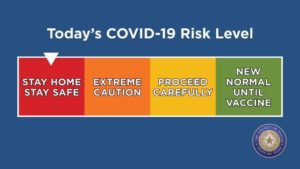 A total of 618 new cases of the novel coronavirus have been reported by Dallas County health officials between Friday and Sunday, and an additional 17 deaths, bringing the county’s total cases up to 7,455, with 176 total deaths.
A total of 618 new cases of the novel coronavirus have been reported by Dallas County health officials between Friday and Sunday, and an additional 17 deaths, bringing the county’s total cases up to 7,455, with 176 total deaths.
For comparison’s sake, the total last Sunday was 5,870, with 143 deaths.
The county reported 199 new cases and five deaths on Friday, 214 new cases and six deaths on Saturday, and 205 cases and six deaths on Sunday.
Deaths include an Irving man in his 30s; a Mesquite man in his 40s; two women in their 60s from Mesquite and Grand Prairie, respectively; two people in their 70s – a Garland woman and a Richardson man; and a Grand Prairie man in his 80s.
Additionally, a Grand Prairie man in his 60s was found dead at his home, and a Dallas woman in her 50s died in a hospital emergency room.
Eight people who had been residents of long-term facilities also died – three from Mesquite, two from Irving, and three from Dallas.
“We closed out our week with a total of 27 deaths, six lower than last week, and the lowest number we’ve had since the week of April 19,” said Dallas County Judge Clay Jenkins Saturday. “Today’s 214 cases puts us at an average of 233 cases a day, down from 246 from last week. This tracks the medical modeling from early April that we would plateau and begin to go down at this time.
“Our last three days of positive cases have been lower than in the previous 10 days and that is a good sign,” Jenkins added Sunday. “Increasingly, it is up to all of you to determine the trajectory of where we go in this COVID-19 pandemic.”
In his evening newsletter, Dallas Mayor Eric Johnson said that 25 hospitals reported their bed availability Sunday. Of the 5,713 total beds, 65% are occupied – which is up from the 61% we reported Monday, but the same as our report from Friday. Of the 826 ICU beds available, 68% (or 562) are occupied, compared to the 544 Friday, the 547 last week, and 532 the weekend before. And 311 of the total 945 ventilators available are currently in use.
Of cases requiring hospitalization who reported employment, about 80% have been critical infrastructure workers including those in healthcare (18%), transportation (16%), food and agriculture – which includes grocery stores and places you can buy food (15%), public works (8%), finance (5%), communications (4%), teachers, real estate, and clergy (8%), and first responders (3%).
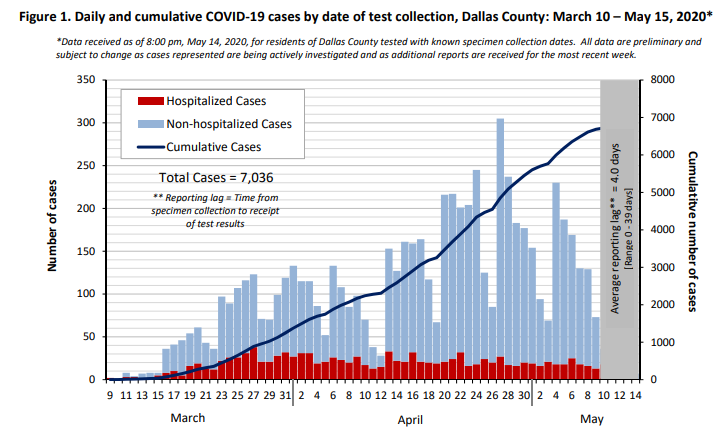
In the county’s May 15 aggregate report, most cases continue to be between the ages of 18 and 60, with the 18-40 age group accounting for 39% of the cases, and the 41-64 age group accounting for 42% of the total cases.
Close contact or community transmission continues to be the biggest risk factor for contracting COVID-19, accounting for roughly 85.1% of all cases. Living in a long-term care facility, being incarcerated in the county jail, and domestic travel are a distant second, third, and fourth, at 5.3%, 4.4%, and 1.8%, respectively. Creeping up, though, are cases from meat and food processing facilities, which now account for 1.4% of all cases in the county.
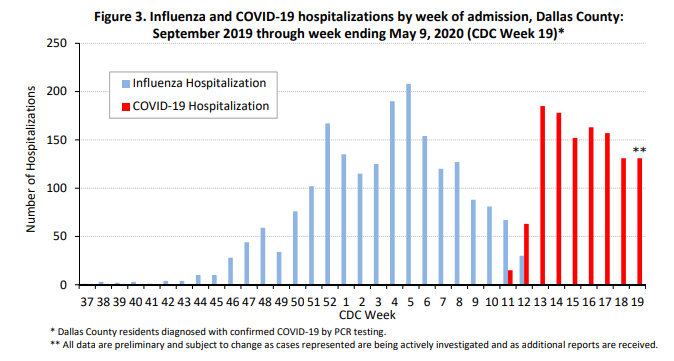
Of the testing done, positive cases accounted for 10.9% of tests at local hospitals as of May 9, down slightly from 11.3% as of May 2, with 453 positives coming from 4,151 tests. However, testing and positive test results of COVID-19 far outpaces any other respiratory virus – even if you combine them all.
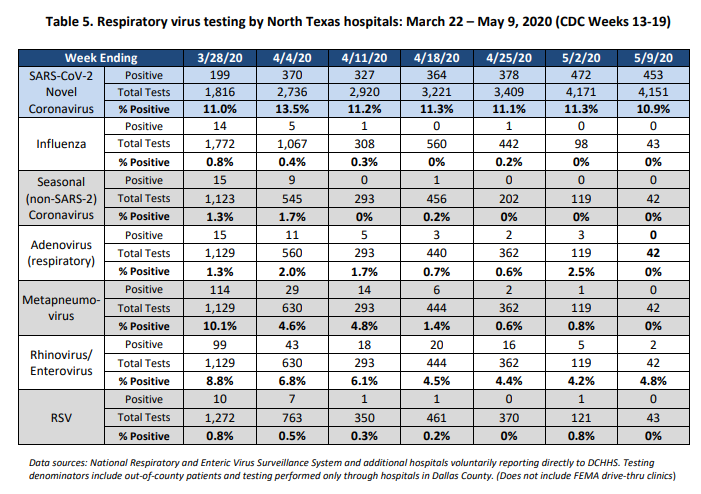
Hospitalizations because of COVID-19 have also eclipsed influenza hospitalizations on a weekly basis, too, and have for some time. It likely won’t be long before total hospitalizations from COVID-19 will eclipse total flu hospitalizations, and ICU admissions and deaths already have eclipsed flu numbers.
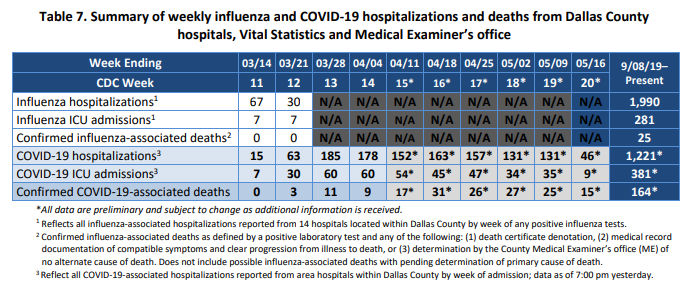
Seventeen percent of all cases ended up hospitalized – 31% ended up in critical care, and 19% ended up on a ventilator.
In a city-by-city breakdown, Dallas still comes in with the highest number of cases – 3,873 , or 55.5%. Highland Park has 18 cases so far, and University Park has 26.
The county does not count recoveries because it’s not a variable being used nationally by the Centers for Disease Control and Prevention, nor by state health departments. However, one can extrapolate that the 83% of total cases that have not been hospitalized – at the very least – are on their way to recovery or have recovered, county officials explained recently.
“The exact number of patients who have been released from area hospitals to continue their recovery at home is not available at this time,” Lauren Trimble, Dallas County Judge Clay Jenkins’ chief of staff, said.
Statewide, 693,276 tests have been administered, with 47,784 testing positive in 222 counties, and 1,336 deaths so far. Those numbers are climbing, however, but hospitalizations are still manageable at this point, officials said.
Looking for more data, and comparisons to state and national figures? The Institute for Urban Policy Research at the University of Texas Dallas has rolled out a robust dashboard full of data.
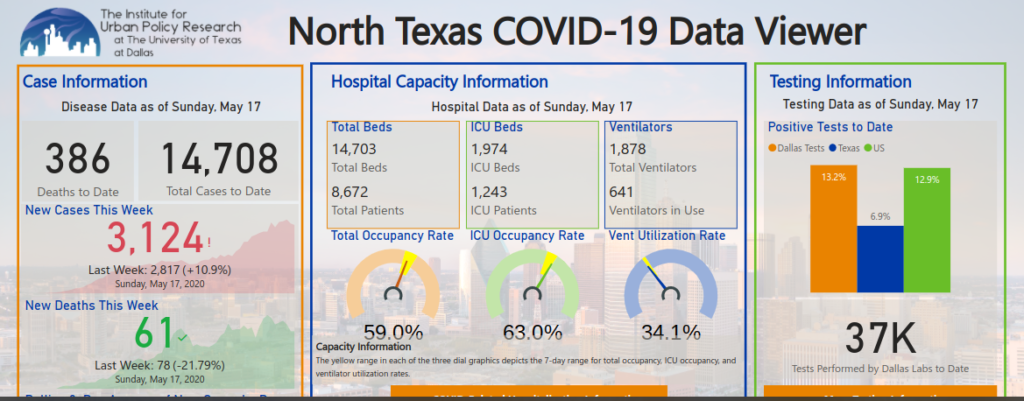
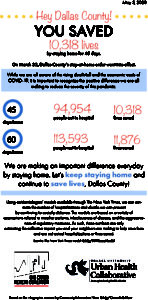
And finally, if you’ve wondered what exactly – as data points – the shelter-in-place orders accomplished, the Big Cities Health Coalition released estimates for member counties and cities who issued shelter-in-place orders early, saying that early action “led to an estimated 2.1 million hospitalizations avoided and over 200,000 lives saved” nationally.
The estimates were based on 45-day stay-at-home or shelter-in-place orders, and were calculated by the Urban Health Collaborative at Drexel University’s Dornsife School of Public Health.
How did Dallas County fare? BCHC estimates that after 60-days, the orders kept 113,593 out of the hospital, and saved 11,876 lives.
“Additionally, a survey conducted in April by NP Strategy Group found that Americans in all regions of the country understand the impact of stay-at-home orders in place across the nation,” the organization said. “It found that, on average, 4 out of 5 (80%) respondents agree that stay-at-home orders helped keep them and their communities healthier and safer during the pandemic, with agreement across age, gender, political, and regional breakouts. At the same time, 75% approve of the actions taken by their local public health leaders, and 68% approve of their elected officials’ decisions.”
Abbott, State Emergency Management To Partner with Local Fire Departments for Nursing Home Testing
Gov. Greg Abbott and the Texas Division of Emergency Management Friday announced that local fire departments in Texas are partnering with local public health authorities to provide testing in nursing homes throughout the state.
This partnership has been developed and is being implemented through an ongoing collaboration between TDEM, the Texas Commission on Fire Protection, the Texas Health and Human Services Commission, and the Texas Department of State Health Services. Costs associated with providing these tests are eligible for federal reimbursement.
“This partnership builds upon our efforts to expand COVID-19 in the Lone Star State, especially among our most vulnerable Texans,” said Abbott. “I thank our local fire departments for continuing to serve their fellow Texans throughout the COVID-19 response. By serving their communities in this new capacity, we will continue to contain the spread of this virus and protect the health and safety of all Texans.”
Buckner Launches Gold Ribbon Campaign in Support of Senior Living
 As we reported above, a troubling number of COVID-19 cases have come from long-term care facilities – placing frontline workers and residents at the epicenter of the pandemic.
As we reported above, a troubling number of COVID-19 cases have come from long-term care facilities – placing frontline workers and residents at the epicenter of the pandemic.
Efforts to slow the spread have also left residents without visitors as state and local officials have put facilities on strict visitor restrictions since March.
In order to increase awareness of senior living residents and the frontline workers caring for them during the COVID-19 pandemic, Buckner Retirement Services is launching a ribbon campaign titled Going Gold for Senior Living. DFW and North Texas residents are encouraged to show their support of senior living communities, like Ventana by Buckner, by displaying a gold ribbon outside their homes during the months of May and June.
All six Buckner senior living communities across Texas hosted drive-thru ribbon pick-up events on May 11 for family members of residents and staff.
Although there have been national and local campaigns to honor healthcare workers, Buckner officials said they felt that there should also be additional focus on those working in long-term care facilities during this time.
“Buckner is focusing specifically on the senior living workers – from nurses to dining services, maintenance, administration and more,” the company said. “Each of these jobs is integral in mitigating risk for residents.”
“The health and safety of our staff and residents are of utmost importance to us,” said Charlie Wilson, senior vice president of Buckner Retirement Services. “All of our associates are a shining example of what it means to be selfless and inspire happiness in the lives of senior adults. As one of the most vulnerable populations, our residents sacrifice family visits to help reduce risks for their neighbors.
“By displaying a gold ribbon outside your home, you can recognize the selfless actions and personal sacrifices made by senior living residents and staff.”
Wilson said he hoped that other senior living communities and nursing facilities across Texas and the U.S. will join in the gold ribbon campaign.
“We are committed to generating awareness through the Going Gold Ribbon campaign across the state of Texas and nationally,” he said. “Whether you have a family member or friend residing or working in a senior living community, or you just want to show your appreciation and support, we hope you’ll join us and go gold.”

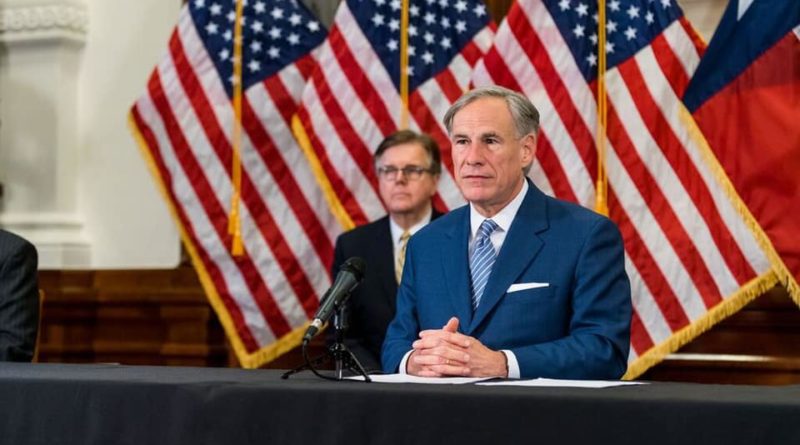








Pingback:Sheltered Diaries: The Smartest Man in Dallas County | People Newspapers
Pingback:Are We Any Good at Social Distancing? | People Newspapers